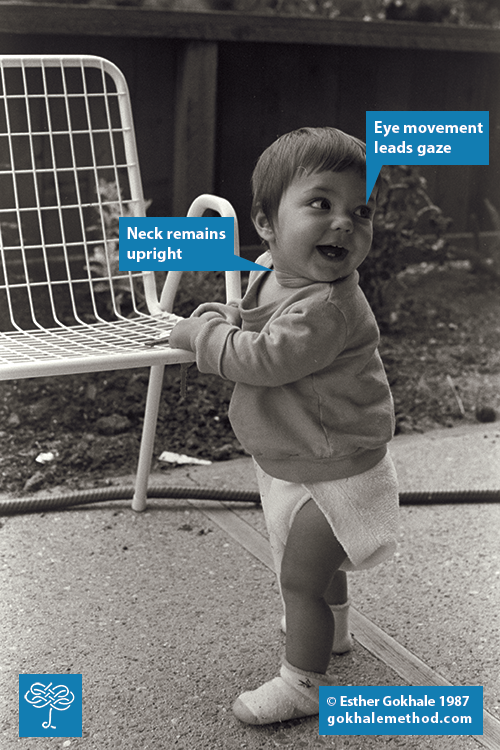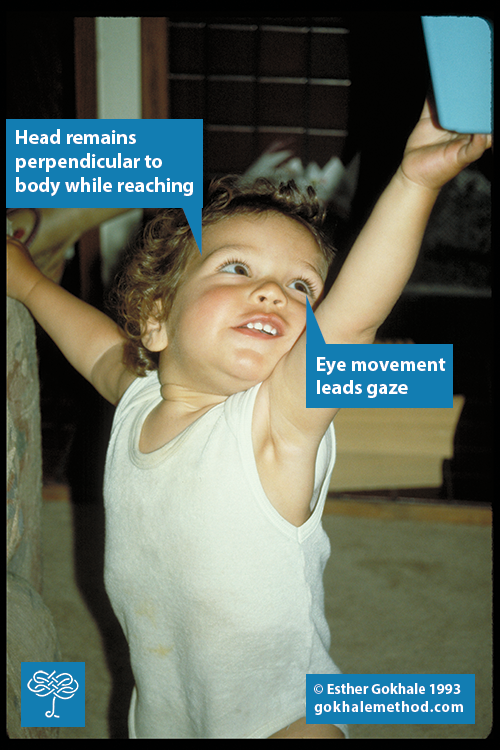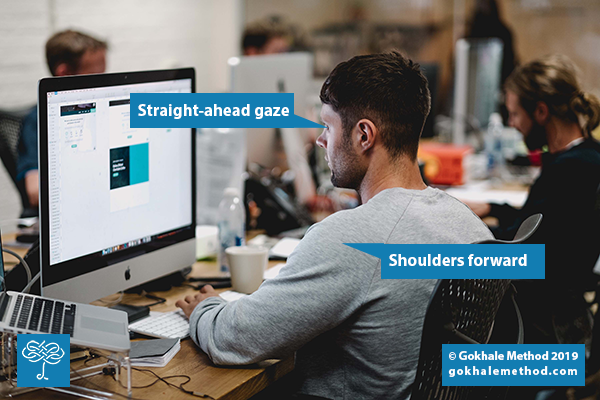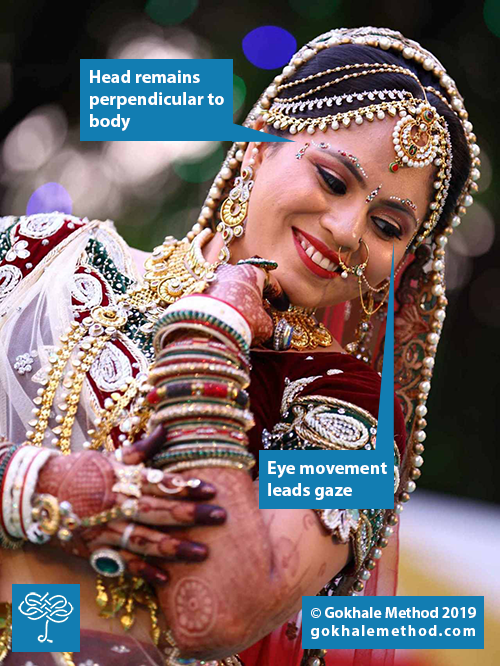My passion for researching posture has taken me far and wide. I was in a village in Burkina Faso in western Africa when I first noticed how people there would track the conversation from speaker to speaker mainly by using their eyes, rather than by turning their heads. Along with their excellent body posture it contributed to a strikingly well-centered, dignified bearing.

This young man in Burkina Faso demonstrates the dignified bearing that comes with an appropriate amount of eye tracking.
Comparing what I saw in Burkina Faso with what I was used to seeing back home, I realized that in the US, and the wider industrialized world, we move our eyes a good deal less and our necks a good deal more. Why such a difference, I wondered, and what is its significance for our well-being?

In Paul Gauguin’s 1893 painting from one of his Tahiti trips, Woman Holding a Fruit, the unnamed subject shifts her gaze with her eyes, rather than by turning or twisting her neck. Public domain image courtesy Wikimedia Commons.
Babies and infants in all cultures track actively with their eyes, both when they are still, and when they turn or reach. One possibility why this changes for children of school age in the industrialized world is due to the amount of reading, writing, and screen time they experience. It seems we grow into a more restrictive, “ahead only” habit.

Infants in all cultures track very actively with their eyes, as my daughter Maya demonstrates here.

My son Nathan tracks with his eyes while reaching for a toy.
As adults, this trend can continue with desk jobs and other prolonged, forward-oriented activities, such as driving. Perhaps this is why, as we age, we develop a more fixed “tunnel vision,” which results in moving our necks rather than our eyes.

Computer and desk work are possible factors in reducing our range of eye movement. Original image courtesy Studio Republic on Unsplash.
Excessive dependence upon neck movement to reorient our visual field often contributes to soft tissue strain and wear and tear on the delicate discs and joints of the cervical vertebrae. Far better, then, to try to reduce this dependence and reintroduce eye tracking now and then.

Time spent in nature provides us a chance to practice our eye tracking. Follow that movement! Photo courtesy Nathan Anderson on Unsplash.
How can we reintroduce this ancient technique into our industrialized-world lives? I am a great advocate for getting out into nature whenever possible to literally expand our horizons. Time spent with young children, especially babies and toddlers, can give us an opportunity to mimic and mirror them — to their frequent delight!

This dancer in San Diego demonstrates beautiful eye tracking. Image courtesy Avnish Choudhary on Unsplash.
Many dance forms, including, but certainly not limited to, classical Indian Bharatnatyam and Kathak, also offer us ample opportunities to practice eye tracking, which lends our dance gestures and movements a depth of emotion. By allowing our eyes to track while on a walk or hike — perhaps while watching a darting squirrel or rabbit cross our path — or while watching a sports game from the stands, or while trying out a new dance style, we can provide ourselves a chance to relearn this method of respecting the neck and maintaining an especially dignified composure.

These elegant dancers in Trinidad and Tobago show the gravitas and depth that can come from skillfully-employed eye tracking. Image courtesy Isaiah McClean on Unsplash.



Comments
Esther, thank you. Inspiring
Esther, thank you. Inspiring. I immediately went to the mirror to practice. What I found is my peripheral vision is just not very good which makes me guess that this issue has a bit of a Catch 22 to it, we might be getting trained, as you suggest, with our schooling and computer work but then this must have a negative effect on our eye muscles and vision over time which might cause our peripheral vision to deteriorate. When this happens it would only increase the tendency to look by turning our whole head - an unending cycle. I am intrigued to improve my peripheral vision now. I think this must be something that would be good for the eyes as well as the neck! And, as you point out, the dignity this neck and eye positioning creates is really beautiful.
I briefly looked into The
I briefly looked into The Alexander Technique and this was a base tenant to is work. In a nutshell, "the body moves where the eyes go". As my meditation practice progressed, my understanding is this has to do with basic embodiment and awareness of our 6 senses. Yes, 6. Thoughts are the mind's sense, and the one that dominates western culture. If we remained in tune with nature and our bodies, a sound or sight or smell would capture our attention. Our eyes are now the second dominant sense organ - I'm guilty being so lost in thought I stop *seeing* what my eyes are inputting! How the body system was designed to work is a sense organ registers a stimulus, the eyes dart in that direction, the head follows the eyes, and finally the body follows the head. Like you say and show - we could learn a lot from an infant!
Really interesting and
Really interesting and stimulatig article and comments.
Yes, the activation order eyes-> head-> body is the same that my cat uses every time something stimulates her senses.
For the developing a better peripheral vision i was wondering about trying an exercise teached by Lee Morrison (Urban Combabtives London, an expert in self defence).
Keeping the hands at the level of your head and watching down in front of you, start to moving your fingers like leaves in the wind and open slowly your arms more and more till you can't perceive the movement of your fingers and repeat.
Lee says that a month of practice have enhanced hes capacity to perceive something in the peripheral area of vision.
You can give it a try and say us if it works.
Playing certain video games
Playing certain video games also helps develop peripheral vison. I forget the reference, but I thought it to be an interesting finding.
Thanks! I will definitely
Thanks! I will definitely try that!
What do you think about maybe
What do you think about maybe practicing use of peripheral vision by turning the head and using the eyes to the side to read a computer screen? Could this help for those who work at a screen? - in addition to more time in nature, of course! :)
Esther,Thank you for covering
Esther,
Thank you for covering this topic. Ever since losing most of the vision in my right eye four years ago I have been acutely aware of the role eye muscles play in posture. I have just enough vision in my right eye to be a nuisance and over time cause me to tilt to the right even more than I had been. I have virtually no peripheral vision and I end up tensing my neck and shoulders which exacerbates my structural problem.
About two and a half months ago I started experimenting with an eye patch on right/left eye doing different things around house--washing dishes, watching TV, doing word puzzle with left hand that requires fine motor skill on iPad, dancing/twirling with the bones, sitting in your chair while stretching concentratiing on eye movements--with rather good success. It carries over into my day and I can realize I'm tensing and relax.
You have mentioned before that twisting comes from the ankles and I think the picture of Maya shows exactly the motion I aspire to but am still blocked. I have been working on my foot/ankle flexibility and it is paying off up the line..
For combatting eye strain
For combatting eye strain while sitting at my computer I practice slightly swivelling my chair first to one side and then to the other while keeping my head still but keeping my eyes on the sreen. It has helped with eye strain and I can see (pun intended) that it could help with this perpendicular posture eye-tracking also. It is very easy to do and doesn't interrupt work concentration.
That's a novel approach which
That's a novel approach which has an additional benefit of strengthening the deeper abdominal (obliques) and back muscles (rotatores). I wonder if this is why some people swivel instinctively (myself included) and if there are still other benefits from doing this - movement in general? A benefit for the brain?...
I noticed when I swivel that
I noticed when I swivel that it mimics an exercise which helped one of my older students (60s) with a chronically stiff neck. I was teaching Callanetics (before discovering GM) and the neck exercises loosened up her neck to the point where she could turn her head to the left for the first time in 15 years. It's a simple super slow turn to one side and then the other, then another which starts with chin to chest, swiveling the neck around and up toward the ceiling, then another super slow swivel around, down, and up to the other side. Three times each. Does the latter chin to chest exercise compromise the spine, Esther?
I noticed so many students bent over their laptops at the library last week, and asked the librarian if they had considered getting some sort of adjustable stands to lift the screens and promote better posture. She was lobbying for a standing desk of her own, and lamenting over the other librarians who constantly readjust the screen downward after she lifts it to a more compatible position. She is average in height, so it should remain at that level or higher!
What does it mean, head
What does it mean, head perpindicular to body? Perpindicular in what plane? You mean not rotated or not tipped to the side? I can't picture this. Thank you!